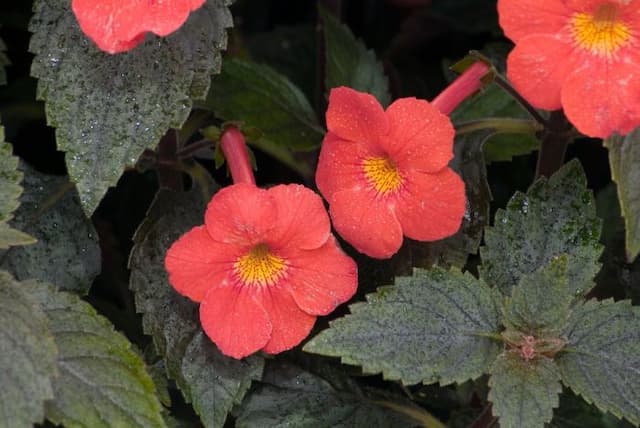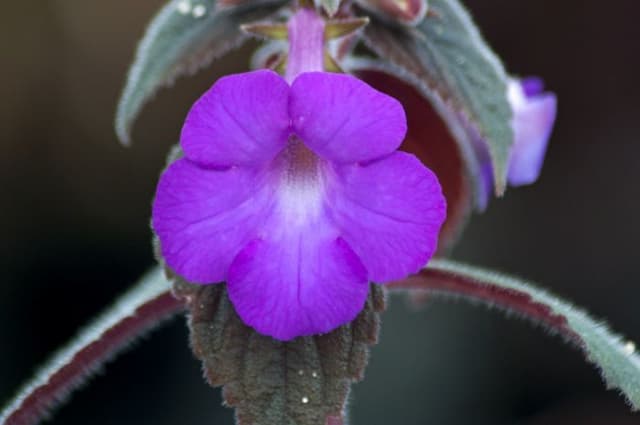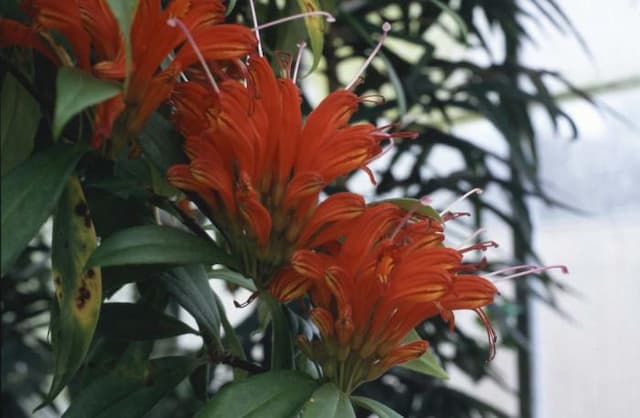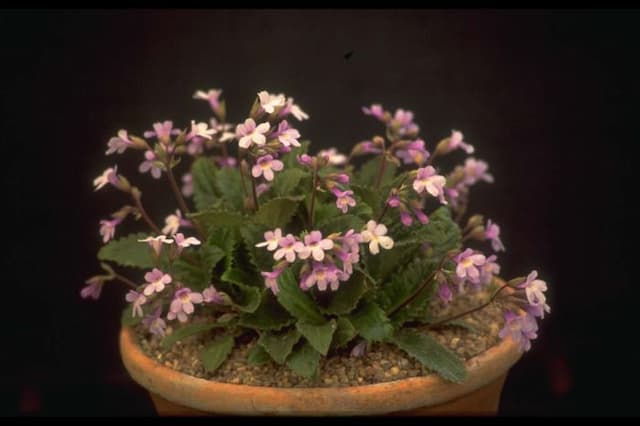Cape Primrose Streptocarpus 'Happy Snappy'
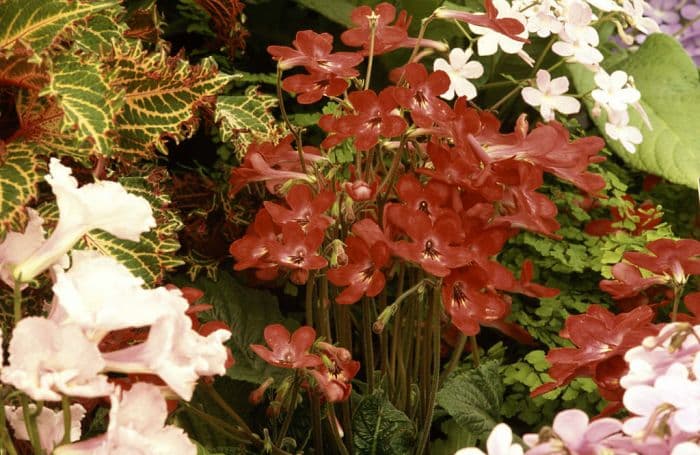
ABOUT
Streptocarpus 'Happy Snappy' is a striking flowering plant known for its lush, attractive foliage and vibrant blooms. The leaves of 'Happy Snappy' are typically long and narrow, with a soft texture and deep green color that provides a perfect backdrop for its flowers. These leaves grow in a basal rosette pattern, emerging from the base of the plant in a clustered fashion which gives the plant a full and verdant appearance. The blossoms of 'Happy Snappy' are its most captivating feature, boasting an eye-catching display of color. The flowers are tubular-shaped with flared, rounded edges, resembling the open mouth of a trumpet. They often come in a mix of two tones, usually presenting bold and bright hues that may include shades of pink, purple, blue, or even a combination of colors with contrasting throats. The petals can have varied patterns such as stripes, speckles, or a bi-color effect, adding to the overall charm of the plant. 'Streptocarpus 'Happy Snappy' has a somewhat delicate look, with the beautiful flowers held aloft on slender stalks that rise above the foliage. It tends to have a generous blooming period, with the potential for flowers to appear throughout the warmer months of the year, providing a long-lasting and eye-catching display. The overall impression of 'Happy Snappy' is one of a lush and colorful specimen that would be a standout addition to any indoor plant collection or a shaded outdoor garden setting.
About this plant
 Names
NamesFamily
Gesneriaceae.
Synonyms
Cape Primrose, Nodding Violet, Twisted Fruit.
Common names
Streptocarpus 'Happy Snappy'.
 Toxicity
ToxicityTo humans
Cape Primrose, commonly known as Streptocarpus 'Happy Snappy', is not considered toxic to humans. There are no well-documented reports of poisoning from ingesting this plant, and it is generally regarded as safe in terms of human interaction. However, it is always advisable to discourage children from eating any houseplants.
To pets
Cape Primrose is not listed as a toxic plant to pets such as dogs and cats. It should not cause any significant symptoms if ingested by a pet. However, ingestion of non-food items can sometimes lead to gastrointestinal upset in pets, such as vomiting or diarrhea, simply from the ingestion of plant material that they are not accustomed to. If your pet has eaten a Cape Primrose and is showing concerning symptoms, it is always best to consult with a veterinarian.
 Characteristics
CharacteristicsLife cycle
Perennials
Foliage type
Evergreen
Color of leaves
Green
Flower color
Varies
Height
1 foot (30 cm)
Spread
1 foot (30 cm)
Plant type
Herb
Hardiness zones
10
Native area
Africa
Benefits
 General Benefits
General Benefits- Decorative Appeal: Streptocarpus 'Happy Snappy', also known as Cape primrose, adds aesthetic value to indoor spaces with its vivid blooms and attractive foliage.
- Long Blooming Period: Cape primrose is known for its long flowering season, often blooming for several months with proper care.
- Low Maintenance: It requires relatively low maintenance compared to other flowering houseplants, making it ideal for busy plant owners.
- Compact Growth: The plant remains compact, which is perfect for small living spaces or windowsills.
- Variety of Colors: The blooms come in various colors, providing options to suit different decorative schemes or preferences.
 Medical Properties
Medical PropertiesThis plant is not used for medical purposes.
 Air-purifying Qualities
Air-purifying QualitiesThis plant is not specifically known for air purifying qualities.
 Other Uses
Other Uses- Photography Subject: Due to their vibrant flowers, Cape primrose can be an excellent subject for botanical photography, providing stunning visual content for photographers and plant enthusiasts.
- Educational Tool: Cape primrose can be used in educational settings to demonstrate plant care, propagation, and the basics of botany to students and plant hobbyists.
- Illustration and Art: With their unique floral structure, Cape primrose can serve as an inspiration for botanical illustrators or artists looking for interesting and colorful plant subjects to draw or paint.
- Craft Incorporation: The flowers of Cape primrose can be used in craft projects, such as pressing for bookmark creations or incorporated into homemade paper for a natural touch.
- Greeting Cards Decoration: The colorful blossoms of Cape primrose can be pressed and used to embellish greeting cards, providing a personal and floral touch to special messages.
- Theme Gardens: Cape primrose can be featured in themed garden displays that showcase various types of flowering plants, adding variety with their unique shape and colors.
- Digital Art Resource: High-resolution images of Cape primrose could be used by digital artists as textures or elements in digital collage work.
- Color Inspiration: The varied color palette of Cape primrose can be used as inspiration for interior design, fashion design, or color schemes in various creative projects.
- Culinary Presentation: While not typically eaten, the non-toxic flowers of Cape primrose can be used as a decorative element on plates or platters in culinary presentations for an added visual appeal.
- Seasonal Decor: Cape primrose can add a vibrant splash of color to seasonal decor during its blooming periods, especially in spring and winter when colors are highly appreciated.
Interesting Facts
 Feng Shui
Feng ShuiThe Cape Primrose is not used in Feng Shui practice.
 Zodiac Sign Compitability
Zodiac Sign CompitabilityThe Cape Primrose is not used in astrology practice.
 Plant Symbolism
Plant Symbolism- Resilience: Commonly known as Cape Primrose, Streptocarpus 'Happy Snappy' symbolizes resilience because it can thrive in varying light conditions and bounce back from neglect.
- Endurance: The long blooming period of the Cape Primrose stands for endurance, showing the plant's capacity to sustain its beauty over time.
- Optimism: The vibrant and cheerful blooms of the Cape Primrose are often associated with a sense of optimism, representing the ability to find joy in life's simple pleasures.
 Water
WaterCape Primrose requires watering when the surface of the soil feels dry to the touch. Water thoroughly using room temperature water, allowing excess water to drain away. Typically, this may mean watering approximately 8-10 ounces per week, but the exact amount can vary based on humidity and temperature conditions in your home. Make sure not to let the plant sit in standing water, as this can lead to root rot. Adjust the frequency of watering during the winter months when the plant is not actively growing, and water less often.
 Light
LightCape Primrose thrives in bright, indirect light. It should be placed near a window that receives plenty of light, but direct sunlight should be avoided, as it can scorch the leaves. An east or west-facing window covered with a sheer curtain is ideal for filtering light and providing the best lighting conditions for robust growth.
 Temperature
TemperatureCape Primrose prefers moderate temperatures, ideally between 60 and 75 degrees Fahrenheit. It can survive minimum temperatures of around 50 degrees Fahrenheit but should be protected from drafts and sudden temperature changes. The maximum temperature should not exceed 80 degrees Fahrenheit for prolonged periods, as excessive heat can stress the plant.
 Pruning
PruningRegularly prune Cape Primrose to encourage bushier growth and remove spent flowers to promote continued blooming. The best time for pruning is in the spring or after the plant has finished a bloom cycle. Deadheading, or removing faded flowers, can be done as needed throughout the year to keep the plant tidy and healthy.
 Cleaning
CleaningAs needed
 Soil
SoilThe best soil mix for Cape Primrose should be light and well-draining, consisting of a combination of potting soil, perlite, and peat moss or coconut coir to retain moisture. A slightly acidic to neutral pH of 5.8 to 6.5 is recommended for optimal growth.
 Repotting
RepottingCape Primrose should be repotted annually or when it outgrows its current pot, usually every 12-18 months. Use fresh soil mix when repotting to provide nutrients and encourage growth.
 Humidity & Misting
Humidity & MistingCape Primrose thrives in moderate to high humidity levels, ideally between 50-60%. Avoid placing the plant in extremely dry environments, as it can inhibit blooming and cause leaf problems.
 Suitable locations
Suitable locationsIndoor
Bright, indirect light; keep soil moist.
Outdoor
Dappled shade; sheltered from harsh conditions.
Hardiness zone
10-11 USDA
 Life cycle
Life cycleThe life of a Cape primrose (Streptocarpus 'Happy Snappy') begins with the germination of small seeds, which prefer warm temperatures and light to commence growth. Upon germination, the seedlings develop into rosettes of leaves and continue to grow, relying on sufficient light, water, and nutrition. The plant enters a vegetative stage where foliage increases in size and quantity, initiating the creation of a robust leafy base. Following this, the Cape primrose starts the reproductive stage, producing flowers that are vibrant and colorful, attracting pollinators for sexual reproduction. After pollination, the flowers develop into twisted seedpods that release seeds, completing the cycle. Between flowerings, this perennial plant may enter a period of dormancy, reducing growth during unfavorable conditions such as winter, only to resume its active growth cycle with the return of favorable circumstances.
 Propogation
PropogationPropogation time
Spring-Early Summer
Streptocarpus 'Happy Snappy', commonly known as Cape Primrose, can be propagated through leaf cuttings, which is the most popular method. This is typically done in the spring or early summer when the plant's growth is most vigorous. To propagate, a healthy leaf is chosen and a section of the leaf, including a main vein, is cut into pieces, each about 2-3 inches (5-7.5 cm) long. The leaf sections are then placed on top of moist potting mix and gently pressed down to make contact with the soil. It's important to keep the soil evenly moist and to provide bright, indirect light until new growth appears, which usually takes a few weeks. As the new plants develop their own root systems, they can be gently separated and potted into individual containers.
